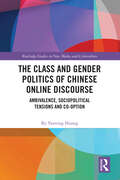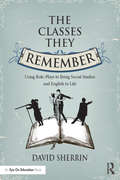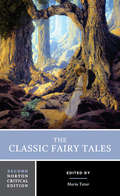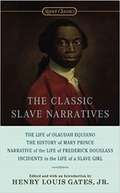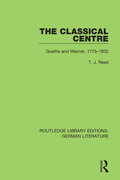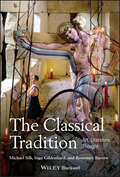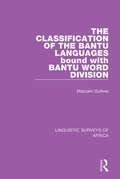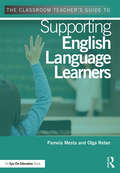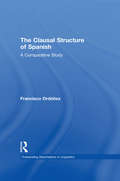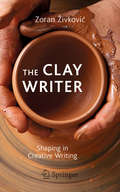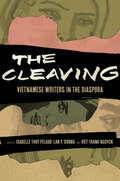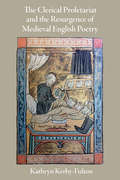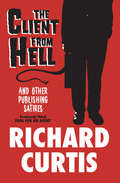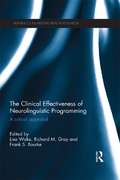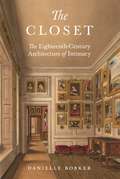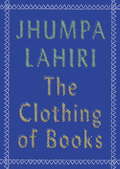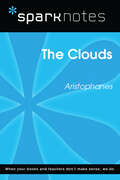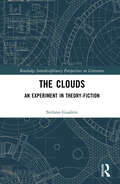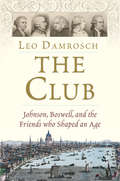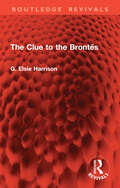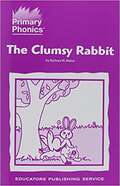- Table View
- List View
The Class and Gender Politics of Chinese Online Discourse: Ambivalence, Sociopolitical Tensions and Co-option (Routledge Studies in New Media and Cyberculture)
by Yanning HuangThis book offers an in- depth study of the quasi- political, self-deprecating, and parodic buzzwords and memes prevalent in Chinese online discourse.Combining discourse analysis with in- depth audience research among the young internet users who deploy these buzzwords in on- and offline contexts, the book explores the historical and social implications of online wordplay for sustaining or challenging the contemporary social order in China. Yanning Huang adopts a combination of media and communications, social anthropology, and socio- linguistic perspectives to shed light on various forms of agency enacted by different social groups in their embracing, negotiation of, or disengagement from online buzzwords, before addressing how the discourses of online wordplay have been co-opted by corporations and party-media.Offering a rigorous and panoramic analysis of the politics and logics of online wordplay in contemporary China, and providing a critical and nuanced analytical framework for studying digital culture and participation in China and elsewhere, this book will be an important resource for scholars and students of media and communication studies, Internet and digital media studies, discourse analysis, Asian studies, and social anthropology.
The Classes They Remember: Using Role-plays And Mock Trials To Bring Social Studies And English To Life
by David SherrinLearn how to use role-plays to bring history and literature to life! When students take on the roles of historical or literary figures, they develop a greater understanding of characters’ identities and motivations, and are able to more deeply explore and reflect upon key issues and themes. In this new book from award-winning teacher David Sherrin, you’ll find out how this lively instructional format will make teaching a more immersive, interactive, and memorable experience for your middle school and high school students. The book includes: <P><P> A clear how-to guide to get the most out of role-playing in your class; Ready-made units and lessons to get you started right away, complete with sample scripts, scaffolding worksheets, and assessment rubrics; Templates and step-by-step instructions to help you design your own role-plays. <P><P> The pre-made units, which Sherrin spent years refining in his classroom, cover historical topics such as the rise of Nazi Germany and the Spanish conquest of the Aztecs. You’ll also find fun and interactive role-plays based on literary works like The Pearl and Fences. These lessons will help students at all ability levels to become better communicators, problem-solvers, and creative thinkers.
The Classic Fairy Tales
by Maria TatarThis Norton Critical Edition collects forty-four fairy tales, from the fifth century to the present. The Classic Fairy Tales focuses on six tale types: "Little Red Riding Hood," "Beauty and the Beast," "Snow White," "Cinderella," "Bluebeard," and "Hansel and Gretel," and presents multicultural variants and sophisticated literary rescriptings. Also reprinted are tales by Hans Christian Andersen and Oscar Wilde. "Criticism" gathers twelve essays that interpret aspects of fairy tales, including their social origins, historical evolution, psychological drama, gender issues, and national identities. A Selected Bibliography is included.
The Classic Fairy Tales (Second Edition) (Norton Critical Editions)
by Maria Tatar“I have used this textbook for four courses on children’s literature with enrollments of over ninety students. It is without doubt the most well organized selection of literary fairy tales and critical commentaries currently available. Students love it.” —Lita Barrie, California State University, Los Angeles This Norton Critical Edition includes: · Seven different tale types: “Little Red Riding Hood,” “Beauty and the Beast,” “Snow White,” “Sleeping Beauty,” “Cinderella,” “Bluebeard,” and “Tricksters.” These groupings include multicultural versions, literary rescriptings, and introductions and annotations by Maria Tatar. · Tales by Hans Christian Andersen and Oscar Wilde. · More than fifteen critical essays exploring the various aspects of fairy tales. New to the Second Edition are interpretations by Ernst Bloch, Walter Benjamin, Max Lüthi, Lewis Hyde, Jessica Tiffin, and Hans-Jörg Uther. · A revised and updated Selected Bibliography.
The Classic Slave Narratives
by Henry Louis GatesNo group of slaves anywhere, in any era, has left such prolific testimony to the horror of bondage as African-American slaves. Here are four of the most notable narratives: The Life of Olaudah Equiano; The History of Mary Prince; Narrative of the Life of Frederick Douglass; and Incidents in the Life of Slave Girl.
The Classical Centre: Goethe and Weimar, 1775-1832
by T. J. ReedOriginally published in 1980, this book examines the nature and significance of Classicism as a literary phenomenon and relates the beginnings of the German variety to the search for a national identity in the circumstances of a politically fragmented eighteenth century Germany. It surveys the pre-classical scene, traces the intellectual currents and the literary forms and material which Classicism was to synthesise, and presents its theoretical basis. The major works of Goethe and Schiller in the decade of their partnership are analysed. Their response to political events is placed in the contemporary context and the divergences which challenge Classicism are discussed.
The Classical Debt: Greek Antiquity in an Era of Austerity
by Johanna Hanink“Greek debt” means one thing to the country’s creditors. But for millions who prize culture over capital, it means the symbolic debt we owe Greece for democracy, philosophy, mathematics, and fine art. Johanna Hanink shows that our idealized image of ancient Greece dangerously shapes our view of the country’s economic hardship and refugee crisis.
The Classical Tradition: Art, Literature, Thought
by Rosemary Barrow Ingo Gildenhard Michael SilkThe Classical Tradition: Art, Literature, Thought presents an authoritative, coherent and wide-ranging guide to the afterlife of Greco-Roman antiquity in later Western cultures and a ground-breaking reinterpretation of large aspects of Western culture as a whole from a classical perspective. Features a unique combination of chronological range, cultural scope, coherent argument, and unified analysis Written in a lively, engaging, and elegant manner Presents an innovative overview of the afterlife of antiquity Crosses disciplinary boundaries to make new sense of a rich variety of material, rarely brought together Fully illustrated with a mix of color and black & white images
The Classification of the Bantu Languages bound with Bantu Word Division (Linguistic Surveys of Africa #11)
by Malcolm GuthrieThe first volume of this pair, The Classification of Bantu Languages, originally published in 1948, investigates the questions arising out of the use of the term Bantu. It establishes and illustrates the criteria used in identifying languages as members of the Bantu family. The technique used in classification is described and its results shown in the form of a series of descriptive classifications of each of the principal areas. As well as the map (not included in the volume due to modern methods of reproduction, but available to view on routledge.com), there is a complete list of languages classified in their groups. The second volume, Bantu Word Division published in the same year, discusses a question which for many years was the subject of protracted controversy, namely the dispute between the conjunctivist and the disjunctivist, with regard to word division. This pamphlet discusses word division from a different angle, and solves the problem in a more conclusive way.
The Classroom Teacher's Guide to Supporting English Language Learners
by Pamela Mesta Olga ReberThis book answers your key questions about educating English Language Learners (ELLs) and offers detailed guidance and concrete applications for your classroom. Designed as a one-stop-shop for classroom teachers of all grade levels and content areas, this book is chock full of essential information, delivered in a practical, concise format. In each chapter, you will find checklists, instructional strategies, tables, tools and ideas for next steps. The resources and examples provided are easy to implement and can be used the next day in your teaching. Topics addressed include: Getting to know your ELLs Considering how culture, language and academic background impact learning Bridging the home/school connection Pairing content and language objectives Gauging learner progress Collaborating with ELL staff Much more!
The Clausal Structure of Spanish: A Comparative Study (Outstanding Dissertations in Linguistics)
by Francisco OrdonezFirst Published in 2000. Routledge is an imprint of Taylor & Francis, an informa company.
The Clay Writer: Shaping in Creative Writing
by Zoran ŽivkovićThis concise book by the well-known Serbian writer and literary researcher summarizes his decade-long experience of teaching creative writing at the Faculty of Philology, University of Belgrade. Always offering attendees four good reasons for not attending his course, or, in a broader perspective, discouraging them from professional writing altogether, the author reflects ultimately on what it really takes to become a writer of literary fiction. This essay, which makes up the first part of this work, is complemented by a selection of witty short stories, forming the second part, and which have been used as templates in the teaching context.
The Cleaving: Vietnamese Writers in the Diaspora (Critical Refugee Studies)
by Isabelle Thuy Pelaud, Lan P. Duong, and Viet Thanh NguyenThe first and only book to gather the voices and perspectives of Vietnamese diasporic authors from across the globe. Edited by Isabelle Thuy Pelaud, Lan P. Duong, and Pulitzer Prize–winning author Viet Thanh Nguyen, The Cleaving brings together Vietnamese artists and writers from around the world in conversation about their craft and how their work has been shaped and received by mainstream culture and their own communities. This collection highlights how Vietnamese diasporic writers speak about having been cleaved—a condition in which they have been separated from, yet still hew to, the country that they have left behind. Composed of eighteen dialogues among thirty-seven writers from France, Indonesia, Kyrgyzstan, Canada, Australia, Israel, and the United States, the book expands on the many lives that Vietnamese writers inhabit. The dialogues touch on family history, legacies of colonialism and militarism, and the writers' own artistic and literary achievements. Taken together, these conversations insist on a deeper reckoning with the conditions of displacement. Featured writers: Hoai Huong Aubert-Nguyen, Amy Quan Barry, Doan Bui, Thi Bui, Lan Cao, Cathy Linh Che, André Dao, Duy Đoàn, Lan P. Duong, Dương Vân Mai Elliott, Le Ly Hayslip, Matt Huynh, Violet Kupersmith, Thanhhà Lại, Vincent Lam, T.K. Lê, Tracey Lien, Marcelino Trương Lực , Nguyễn Phan Quế Mai, Anna Möi, Beth (Bich) Minh Nguyen, Diana Khoi Nguyen, Hieu Minh Nguyen, Hoa Nguyen, Philip Nguyễn, Thảo Nguyễn, Vaan Nguyen, Viet Thanh Nguyen, Isabelle Thuy Pelaud, Andrew X. Pham, Aimee Phan, Abbigail Nguyen Rosewood, Bao Phi, Dao Strom, Kim Thúy, Paul Tran, Monique Truong, Minh Huynh Vu, Ocean Vuong
The Clerical Proletariat and the Resurgence of Medieval English Poetry (The Middle Ages Series)
by Kathryn Kerby-FultonDespite the great literary achievements of Chaucer, Langland, and the Pearl Poet, Ricardian English books were still a niche market in 1400. As Kathryn Kerby-Fulton shows, however, their generation was transformational in nurturing the resurgence of English writing, in part as a result of the mass underemployment of clerks originally trained for the church but unable to find steady positions in it. Surviving instead as ecclesiastical or choral "piece workers," or in secular jobs in government or private households, this "clerical proletariat" lived and worked in liminal spaces between the ecclesiastical and lay world. And there the most enterprising found new material—and new audiences—for poetry in English.Since English book production in London prior to 1380 was rare, Kerby-Fulton's study begins in the prior century with great regional poets, revealing their early experimentation with a new poetics of vocational crisis. Preoccupied with underemployment, patronage, careerist ambition, alienation, and changing literary fashion, these thirteenth-century writers were choosing the more avant garde option of writing in English while feeling backwards to earlier tradition in works such as Laȝamon's Brut and The Owl and the Nightingale. These early experimenters invoked semi-remembered literary forms in a still evolving written vernacular, breaking ground for Ricardian writers, who turned to these conventions during the massive clerical unemployment of the Great Schism era. Kerby-Fulton's is the first study of Langland's legacy of articulating an authorial employment crisis, and its echoes in Hoccleve and Audelay. It also uses new tools for uncovering proletarian writers in unattributed Middle English works, including the famous Harley 2253 lyrics, the "York Realist's" Second Trial from the York Cycle, St. Erkenwald, and Wynnere and Wastour. Taking in proletarian themes, including class, meritocracy, the abuse of children ("Choristers' Lament"), the gig economy, precarity, and the breaking of intellectual elites (Book of Margery Kempe), The Clerical Proletariat and the Resurgence of Medieval English Poetry speaks to both past and present employment urgencies.
The Client from Hell: And Other Publishing Satires
by Richard CurtisPreviously titled FOOL FOR AN AGENT. An alien space explorer seeking intelligent worlds discovers one inhabited by life forms known as publishers, and concludes that this world is not worth another visit; another voyager lands on Earth and selects a literary agent to represent his book and movie rights; a freelance writer is so outraged over a lousy royalty statement, he drills his publisher with a gun. These are just a few glimpses of this hilarious collection of lampoons of the publishing industry by prominent literary agent Richard Curtis. Never again will you look at your editor with a straight face.
The Clinical Effectiveness of Neurolinguistic Programming: A Critical Appraisal (Advances in Mental Health Research)
by Lisa Wake Richard M. Gray Frank S. BourkeDespite widespread use, Neurolinguistic Programming (NLP) is a topic of much debate, often receiving criticism from academic and professional sectors. In this book international academics, researchers and therapists are brought together to examine the current evidence of the clinical efficacy of NLP techniques, considering how NLP can be effective in facilitating change, enrichment and symptom relief. Lisa Wake and her colleagues provide a critical appraisal of evidence-based research in the area to indicate the benefits of the approach and identify the need for an increase in randomized well-controlled clinical trials. Contributors also explore how NLP has been used to treat various disorders including: post-traumatic stress disorder phobias addictions anxiety disorders mild depression. Illustrated throughout with clinical examples and case studies, this book is key reading for practitioners and researchers interested in NLP, as well as postgraduate students.
The Clockwork Muse
by Eviatar ZerubavelFor anyone who has blanched at the uphill prospect of finishing a long piece of writing, this book holds out something more practical than hope: it offers a plan. The Clockwork Muse is designed to help prospective authors develop a workable timetable for completing long and often formidable projects. The idea of dashing off a manuscript in a fit of manic inspiration may be romantic, but it is not particularly practical. Instead, Eviatar Zerubavel, a prolific and successful author, describes how to set up a writing schedule and regular work habits that will take most of the anxiety and procrastination out of long-term writing, and even make it enjoyable. The dreaded "writer's block" often turns out to be simply a need for a better grasp of the temporal organization of work. The Clockwork Muse rethinks the writing process in terms of time and organization. It offers writers a simple yet comprehensive framework that considers such variables as when to write, for how long, and how often, while keeping a sense of momentum throughout the entire project. It shows how to set priorities, balance ideals against constraints, and find the ideal time to write. For all those whose writing has languished, waiting for the "right moment," The Clockwork Muse announces that the moment has arrived.
The Closet: The Eighteenth-Century Architecture of Intimacy
by Danielle BobkerA literary and cultural history of the intimate space of the eighteenth-century closet—and how it fired the imaginations of Pepys, Sterne, Swift, and so many other writers Long before it was a hidden storage space or a metaphor for queer and trans shame, the closet was one of the most charged settings in English architecture. This private room provided seclusion for reading, writing, praying, dressing, and collecting—and for talking in select company. In their closets, kings and duchesses shared secrets with favorites, midwives and apothecaries dispensed remedies, and newly wealthy men and women expanded their social networks. In The Closet, Danielle Bobker presents a literary and cultural history of these sites of extrafamilial intimacy, revealing how, as they proliferated both in buildings and in books, closets also became powerful symbols of the unstable virtual intimacy of the first mass-medium of print. <P><P>Focused on the connections between status-conscious—and often awkward—interpersonal dynamics and an increasingly inclusive social and media landscape, The Closet examines dozens of historical and fictional encounters taking place in the various iterations of this room: courtly closets, bathing closets, prayer closets, privies, and the "moving closet" of the coach, among many others. In the process, the book conjures the intimate lives of well-known figures such as Samuel Pepys and Laurence Sterne, as well as less familiar ones such as Miss Hobart, a maid of honor at the Restoration court, and Lady Anne Acheson, Swift's patroness. <P><P>Turning finally to queer theory, The Closet discovers uncanny echoes of the eighteenth-century language of the closet in twenty-first-century coming-out narratives.Featuring more than thirty illustrations, The Closet offers a richly detailed and compelling account of an eighteenth-century setting and symbol of intimacy that continues to resonate today.
The Closure of Space in Roman Poetics
by Victoria RimellThis ambitious book investigates a major yet underexplored nexus of themes in Roman cultural history: the evolving tropes of enclosure, retreat and compressed space within expanding, potentially borderless empire. In Roman writers' exploration of real and symbolic enclosures - caves, corners, villas, bathhouses, the 'prison' of the human body itself - we see the aesthetic, philosophical and political intersecting in fascinating ways, as the machine of empire is recast in tighter and tighter shapes. Victoria Rimell brings ideas and methods from literary theory, cultural studies and philosophy to bear on an extraordinary range of ancient texts rarely studied in juxtaposition, from Horace's Odes, Virgil's Aeneid and Ovid's Ibis, to Seneca's Letters, Statius' Achilleid and Tacitus' Annals. A series of epilogues puts these texts in conceptual dialogue with our own contemporary art world, and emphasizes the role Rome's imagination has played in the history of Western thinking about space, security and dwelling.
The Clothing of Books
by Jhumpa LahiriHow do you clothe a book? In this deeply personal reflection, Pulitzer Prize-winning author Jhumpa Lahiri explores the art of the book jacket from the perspectives of both reader and writer. Probing the complex relationships between text and image, author and designer, and art and commerce, Lahiri delves into the role of the uniform; explains what book jackets and design have come to mean to her; and how, sometimes, "the covers become a part of me."
The Clouds (SparkNotes Literature Guide Series)
by SparkNotesThe Clouds (SparkNotes Literature Guide) by Aristophanes Making the reading experience fun! Created by Harvard students for students everywhere, SparkNotes is a new breed of study guide: smarter, better, faster.Geared to what today's students need to know, SparkNotes provides:chapter-by-chapter analysis explanations of key themes, motifs, and symbols a review quiz and essay topics Lively and accessible, these guides are perfect for late-night studying and writing papers.
The Clouds: An Experiment in Theory-Fiction (Routledge Interdisciplinary Perspectives on Literature)
by Stefano GualeniOn a slow autumn afternoon, an atmospheric physicist working at the Malta Weather Station receives a surprising email from a colleague working in the United Kingdom: something troubling has apparently been detected during one of their research flights. The ensuing meteorological mystery is the starting point for the science fiction novella The Clouds. Alongside the novella, this book features three essays written by the same author that discuss in a more explicit and conventional way three philosophical ideas showcased in The Clouds: the expressive use of fictional games within fictional worlds; the possibility for existential meaning within simulated universes; and the unnatural narratological trope of "unhappening." With its unique format, this book is a fresh reflection on the mediatic form of philosophy and a compelling argument for the philosophical value of fiction.
The Club: Johnson, Boswell, and the Friends Who Shaped an Age
by Leo DamroschPrize-winning biographer Leo Damrosch tells the story of “the Club,” a group of extraordinary writers, artists, and thinkers who gathered weekly at a London tavern In 1763, the painter Joshua Reynolds proposed to his friend Samuel Johnson that they invite a few friends to join them every Friday at the Turk’s Head Tavern in London to dine, drink, and talk until midnight. Eventually the group came to include among its members Edmund Burke, Adam Smith, Edward Gibbon, and James Boswell. It was known simply as “the Club.” In this captivating book, Leo Damrosch brings alive a brilliant, competitive, and eccentric cast of characters. With the friendship of the “odd couple” Samuel Johnson and James Boswell at the heart of his narrative, Damrosch conjures up the precarious, exciting, and often brutal world of late eighteenth‑century Britain. This is the story of an extraordinary group of people whose ideas helped to shape their age, and our own.
The Clue to the Brontës (Routledge Revivals)
by G. Elsie HarrisonOriginally published in 1948, The Clue to the Brontës was written in part as response to a previous biography of Charlotte Brontë by Mrs Gaskell. The author argues that Gaskell's biography gets it all wrong. Harrison draws connections between Patrick Brontë and John Wesley. She finds Gaskell paid too much attention to gossip and did not verify her facts. The influence of John Wesley and the revival of evangelical religion is seen as a force in the Romantic Movement's impact on the English novel. The same influence is here seen to be at work in the writings of the Brontës, including those of their father Patrick.
The Clumsy Rabbit (Primary Phonics #Set 5 Book 10)
by Barbara W. MakarA systematic, phonics-based early reading program that includes: the most practice for every skill, decodable readers for every skill, and reinforcement materials--help struggling students succeed in the regular classroom
